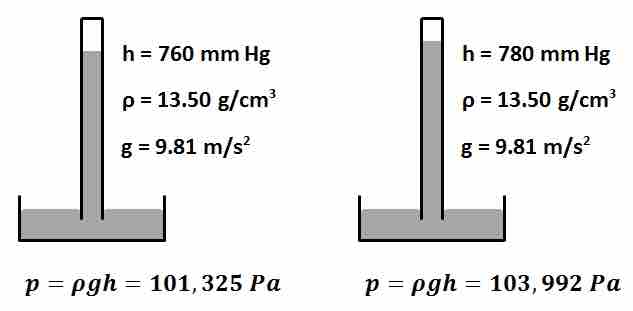Gauge Pressure
In practice, pressure is most often measured in terms of gauge pressure. Gauge pressure is the pressure of a system above atmospheric pressure. Since atmospheric pressure is mostly constant with little variation near sea level, where most practical pressure measurements are taken, it is assumed to be approximately 101,325 Pa. Modern pressure measuring devices sometimes have incorporated mechanisms to account for changes in atmospheric pressure due to elevation changes. Gauge pressure is much more convenient than absolute pressure for practical measurements and is widely used as an established measure of pressure. However, it is important to determine whether it is necessary to use absolute (gauge plus atmospheric) pressure for calculations, as is often the case for most calculations, such as those involving the ideal gas law. Pressure measurements have been accurately taken since the mid-1600s with the invention of the traditional barometer. Barometers are devices used to measure pressure and were initially used to measure atmospheric pressure.
Hydrostatic Based Barometers
Early barometers were used to measure atmospheric pressure through the use of hydrostatic fluids. Hydrostatic based barometers consist of columnar devices usually made from glass and filled with a static liquid of consistent density. The columnar section is sealed, holds a vacuum, and is partially filled with the liquid while the base section is open to the atmosphere and makes an interface with the surrounding environment . As the atmospheric pressure changes, the pressure exerted by the atmosphere on the fluid reservoir exposed to the atmosphere at the base changes, increasing as the atmospheric pressure increases and decreasing as the atmospheric pressure decreases. This change in pressure causes the height of the fluid in the columnar structure to change, increasing in height as the atmosphere exerts greater pressure on the liquid in the reservoir base and decreasing as the atmosphere exerts lower pressure on the liquid in the reservoir base. The height of the liquid within the glass column then gives a measure of the atmospheric pressure. Pressure, as determined by hydrostatic barometers, is often measured by determining the height of the liquid in the barometer column, thus the torr as a unit of pressure, but can be used to determine pressure in SI units . Hydrostatic based barometers most commonly use water or mercury as the static liquid. While the use of water is much less hazardous than mercury, mercury is often a better choice for fabricating accurate hydrostatic barometers. The density of mercury is much higher than that of water, thus allowing for higher accuracy of measurements and the ability to fabricate more compact hydrostatic barometers. In theory, a hydrostatic barometer can be placed in a closed system to measure the absolute pressure and the gauge pressure of the system by subtracting the atmospheric pressure.
Aneroid Barometer
Another type of barometer is the aneroid barometer, which consists of a small, flexible sealed metal box called an aneroid cell. The aneroid cell is made from beryllium-copper alloy and is partially evacuated. A stiff spring prevents the aneroid cell from collapsing. Small changes in external air pressure cause the cell to expand or contract. This expansion and contraction is amplified by mechanical mechanisms to give a pressure reading. Such pressure measuring devices are more practical than hydrostatic barometers for measuring system pressures. Many modern pressure measuring devices are pre-engineered to output gauge pressure measurements. While the aneroid barometer is the underlying mechanism behind many modern pressure measuring devices, pressure can also be measured using more advanced measuring mechanisms.

Hydrostatic Column Barometer
The concept of determining pressure using the fluid height in a hydrostatic column barometer

Variation of Pressure with Height
The density of the liquid is p, g is the acceleration due to gravity, and h is the height of the fluid in the barometer column.